Exploring religion in Brazil reveals a vibrant mosaic of faiths, each painting its unique hue on the country’s spiritual canvas.
Key Takeaways:
- Brazil’s religious landscape is diverse, featuring Catholicism, Protestantism (Evangélicos), Spiritism, Umbanda, Candomblé, and unique practices like Santo Daime and Indigenous Shamanism.
- Brazilian syncretism highlights the blending of various religious traditions, creating a uniquely inclusive spiritual culture.
- Major religious temples, such as the Christ the Redeemer statue, the Basilica of the National Shrine of Our Lady of Aparecida, and the Cathedral of Brasília, are not only places of worship but also symbols of Brazil’s rich religious heritage.
- The interplay of different faiths reflects Brazil’s broader cultural values of diversity, tolerance, and unity.
Welcome to our vibrant journey through the spiritual heart of Brazil, a country where faith and passion intertwine in the rhythm of daily life.
Here, belief in the divine paints every corner, every festival, and every smile you encounter. In Brazil, a staggering 90% of the population affirms their belief in God, showcasing a profound spiritual landscape that is as diverse as its people.
From the echoing hymns in grand cathedrals to the rhythmic drumbeats in hidden Terreiros, the Brazilian faith experience is a mosaic of traditions waiting to be explored.
As a Brazilian eager to share the soul of my country, I invite you to dive deep into this guide, exploring the most popular religions, uniquely Brazilian spiritual paths, and the majestic temples that stand as testaments to our devotion.
Religion in Brazil: The 4 Most Popular
Around 90% of the Brazilian population say they believe in God, according to a 2020 survey, of which 76% say they follow a religion, identifying themselves as:
- Catholics – 50%
- Evangelicals (Protestants) – 31%
- Spiritualists – 3%
- Umbandists – 2%
Another 10% say they have no religion, 2% follow other religions with less appeal in Brazil, and 1% say they are Atheists.
Check out a little more about the 4 most practiced religion in Brazil:
Plan your trip to Brazil
- Find the cheapest flights
- Discover the best accommodation
- Explore this incredible country with the best experiences
- Stay connected at all times with an eSIM
Catholicism
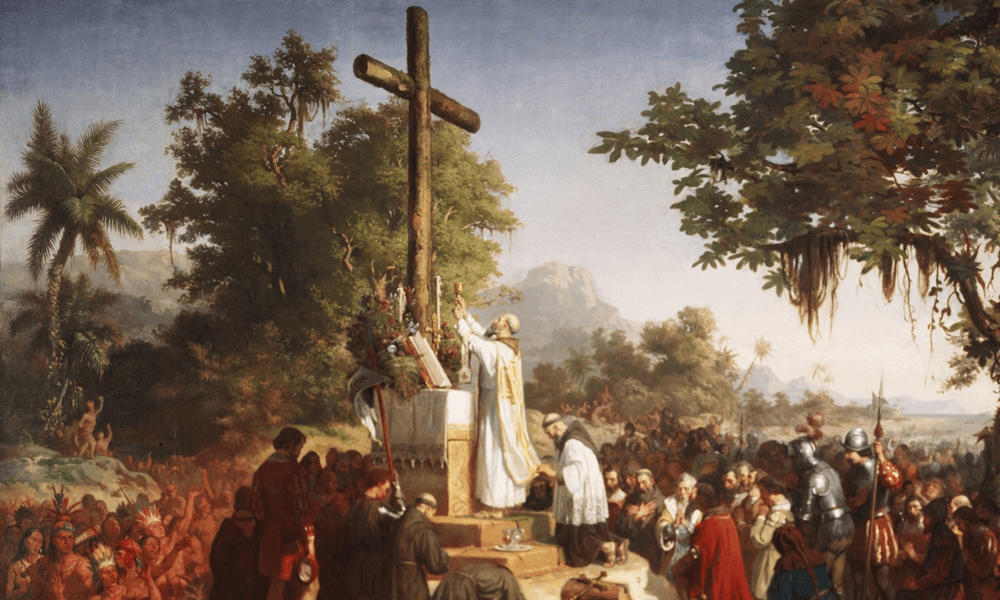
Brazil’s heart beats with the pulse of Catholicism, a faith that arrived with Portuguese colonizers in the 16th century and has since woven itself into the very fabric of our nation.
Catholicism here is not just a religion; it’s a vibrant, living tradition that infuses our festivals, our streets, and our daily lives with a sense of the divine.
Festivals and Celebrations
Brazilian Catholicism is renowned for its colorful, joyous festivals. The most famous of these is undoubtedly Festa Junina, celebrating saints like St. John with bonfires, traditional dances, and costumes.
These festivals are not just parties; they’re expressions of faith, community, and the Brazilian spirit.
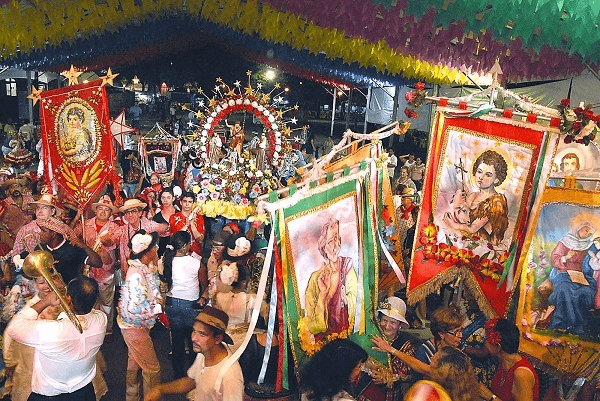
Marian Devotion
In Brazil, the Virgin Mary holds a special place in the hearts of the faithful.
The National Shrine of Our Lady of Aparecida, the patroness of Brazil, is a testament to this devotion.
Millions of pilgrims visit her basilica annually, making it one of the most significant Marian shrines worldwide. This devotion is a vivid illustration of Brazilian Catholicism’s emotive and inclusive character.
The Church’s Role in Society
The Catholic Church plays a pivotal role in Brazilian society, offering guidance and support to the community. Beyond spiritual matters, the Church is involved in social justice, education, and healthcare, working tirelessly to uplift the less fortunate.
This active engagement reflects the Church’s deep commitment to living out the Gospel’s teachings in service to others.
A Living Tradition
Catholicism in Brazil is a living tradition, continuously evolving while staying rooted in its rich history. It’s a faith that embraces the local culture, adapting and growing with it.
From the iconic Christ the Redeemer statue overlooking Rio de Janeiro to the smallest chapel in a remote village, Catholic symbols and practices are a testament to the enduring and adaptable nature of this faith in Brazil.
Protestant
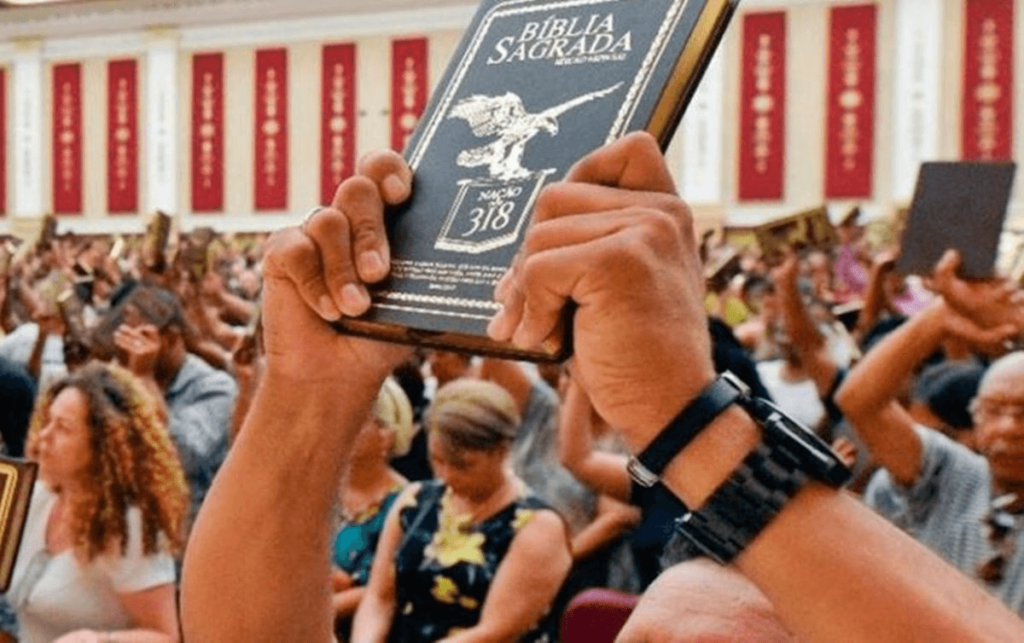
In Brazil, the tapestry of faith is rich and varied, with Protestantism—or as we affectionately call it, “Evangélicos”—claiming a significant and vibrant thread.
Flourishing especially in recent decades, this diverse religious landscape includes Baptists, Pentecostals, Lutherans, and many other denominations, each contributing to the dynamic spiritual life of Brazil.
Rapid Growth and Diversity
The growth of Evangelical Christianity in Brazil has been nothing short of explosive. From lively Pentecostal congregations to the more traditional Reformed churches, Brazilian Protestantism is characterized by its diversity.
This growth is not just in numbers but in the variety of worship styles, theological emphases, and community engagements that reflect the multifaceted nature of Brazilian society.
Pentecostalism: A Driving Force
Pentecostalism, in particular, has been a driving force in this expansion.
Churches like the Assembleia de Deus (Assembly of God) have become household names, known for their passionate worship, vibrant music, and a strong emphasis on personal conversion experiences.
Pentecostal churches are also at the forefront of media use in evangelism, utilizing television, radio, and social media to reach wide audiences.
Social and Political Impact
Evangélicos have made a significant impact on Brazilian society and politics. With a focus on family values, social issues, and a conservative agenda, Evangelical leaders and their congregations have become influential voices in shaping public policy and discourse.
This involvement has brought about a new dynamic in Brazilian politics, reflecting the growing importance of Evangelical Christianity in the country’s social fabric.
Community and Social Services
Beyond their spiritual and political influence, Evangelical churches play a crucial role in community support and social services.
Many churches offer programs addressing poverty, drug addiction, and other social issues, embodying their commitment to practical expressions of their faith.
This aspect of Evangelical Christianity highlights a deep concern for the well-being of the broader community, beyond the walls of the church.
A Faith of Personal Transformation
At its core, Brazilian Protestantism emphasizes personal transformation through faith. This message resonates deeply in a country marked by disparities and challenges, offering hope and a path to a new life for many.
The personal testimony, a hallmark of Evangelical tradition, serves as a powerful tool for individual and community upliftment.
Spiritism
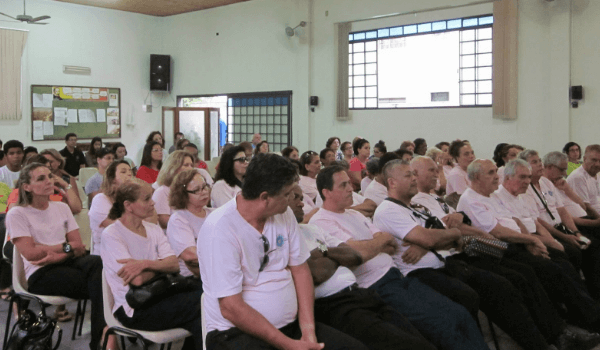
Spiritism, a faith uniquely intertwined with the cultural and spiritual fabric of Brazil, offers a distinct perspective on the divine and the afterlife.
Rooted in the teachings of French educator Allan Kardec in the 19th century, Brazilian Spiritism blends Christian morality with a belief in reincarnation, spirit communication, and the continuous evolution of the soul.
A Bridge Between Worlds
At the heart of Brazilian Spiritism is the concept of mediumship—the ability to communicate with the spirits of the deceased.
This practice is seen not as a mystical endowment for a select few but as a natural ability that many can develop.
Spiritist centers across Brazil serve as hubs for this interaction, providing guidance, healing, and education to those seeking to connect with the spiritual realm.
Healing and Charity
A cornerstone of Spiritism is its focus on healing—both physical and spiritual. Spiritist centers often offer “passes,” a form of energy healing believed to balance the body and spirit. Furthermore, charity is a fundamental aspect of Spiritist practice.
Many centers run volunteer programs, soup kitchens, and hospitals, embodying the Spiritist belief in the importance of altruistic deeds for spiritual growth.
Integration with Brazilian Culture
Spiritism has seamlessly integrated into Brazilian society, influencing art, literature, and even popular media. Its principles resonate with the broader Brazilian ethos of empathy, community support, and resilience in the face of adversity.
Spiritist beliefs and practices are often featured in novels, films, and TV shows, reflecting the philosophy’s widespread acceptance and influence.
The main person responsible for spreading Spiritism in Brazil was the famous medium Chixo Xavier, who even though he passed away in 2002, remains very influential for the religion to this day.

Educational Efforts
Education plays a significant role in Spiritism, with many centers offering courses on moral and spiritual development, the works of Allan Kardec, and the science behind mediumship.
This educational approach aims to demystify the spiritual world, promoting a rational understanding of the phenomena associated with Spiritism.
Spiritism and Social Issues
Brazilian Spiritism often addresses social and personal issues from a spiritual perspective, offering insights into the root causes of societal challenges and individual suffering.
By emphasizing the impact of moral choices on both current and future lives, Spiritism encourages individuals to lead lives of integrity, compassion, and altruism.
Ubanda
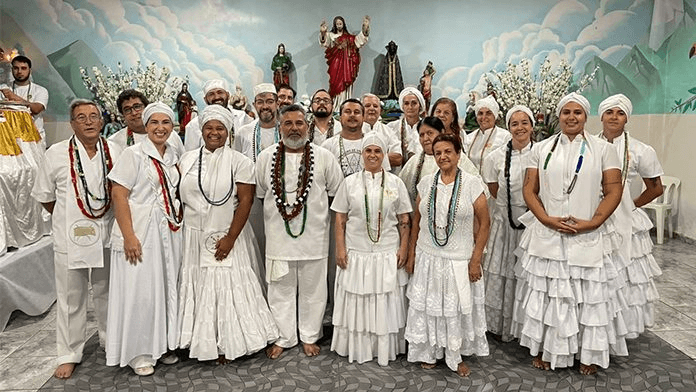
Umbanda, a uniquely Brazilian spiritual tradition, is a harmonious blend of African, Indigenous, and European influences, creating a vibrant mosaic of faith that is as diverse and inclusive as Brazil itself.
Born in the early 20th century, Umbanda offers a unique approach to spirituality, emphasizing harmony with nature, the power of the ancestors, and the presence of orixás (African deities) and entidades (spirits) in everyday life.
Also See | Exploring the Deep Meanings of Samba: Culture, Identity, and History in Brazil
A Melting Pot of Beliefs
At its core, Umbanda is a syncretic faith, merging African religious traditions brought by enslaved people, Indigenous South American beliefs, and elements of Spiritism and Catholicism.
This amalgamation reflects Brazil’s multicultural identity, making Umbanda a truly Brazilian religion. The practice of Umbanda is characterized by its open and eclectic nature, welcoming individuals from all walks of life.
The Pantheon of Orixás and Entidades
Umbanda practitioners worship a pantheon of orixás, each representing natural forces and human aspects of life, such as love, justice, and wisdom.
Alongside them, a host of entidades work with mediums (médiuns) in Umbanda rituals to provide guidance, healing, and protection.
These include Preto Velhos (spirits of old enslaved Africans), Caboclos (spirits of Indigenous ancestors), and Crianças (child spirits), among others.
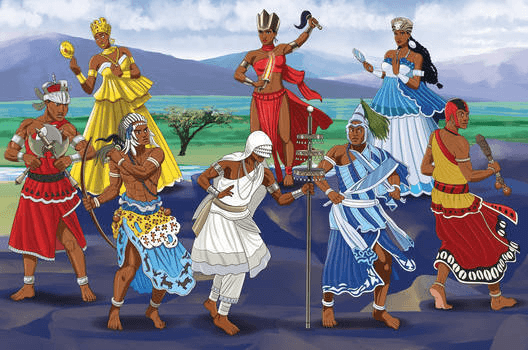
Rituals and Celebrations
Umbanda rituals are rich, colorful ceremonies filled with music, dance, and offerings. Participants gather in Terreiros (ritual spaces) to connect with the spiritual realm through songs (pontos), drumming, and vibrant dances.
These rituals serve multiple purposes, from healing and spiritual consultation to the celebration of the orixás. The inclusive atmosphere of Umbanda ceremonies reflects the religion’s core values of love, charity, and social justice.
Healing and Social Work
A significant aspect of Umbanda is its emphasis on healing and social work. Many terreiros offer community services, including spiritual healing sessions, counseling, and charity work, reflecting the faith’s commitment to aiding those in need.
This practical application of spiritual beliefs to improve people’s lives is a testament to Umbanda’s deeply ingrained ethic of care and service.
Umbanda in Brazilian Culture
Umbanda has left a profound imprint on Brazilian culture, influencing music, art, and literature.
The religion’s rich symbolism and captivating rituals have inspired countless artists and writers, contributing to a broader understanding and appreciation of Umbanda’s spiritual depth.
Despite facing prejudice and misunderstanding, Umbanda continues to thrive as a vital expression of Brazil’s religious diversity and cultural creativity.
Find out more about the sad growth of prejudice against Ubanda and other religions of African origin in Brazil:
Brazil Unique Religions
Brazil’s spiritual landscape is a testament to innovation and syncretism, giving birth to unique religions that mirror its rich cultural tapestry.
These faiths, distinctly Brazilian, offer fascinating insights into the country’s soul, blending traditions to create something truly special.
Ubanda
As you’ve already seen, Ubanda is a religion that was invented in Brazil.
It uniquely blends African religious traditions, brought by enslaved Africans, with Indigenous South American spirituality, Catholic elements, and Kardecist Spiritism.
This synthesis reflects Brazil’s multicultural identity, creating a religion that is distinctly Brazilian.
Umbanda’s invention was a response to social and cultural needs, providing a spiritual path that embraced inclusivity, social justice, and the reconciliation of diverse spiritual practices.
It stands as a symbol of Brazil’s ability to create unity through diversity, offering a spiritual haven that celebrates the rich tapestry of the nation’s cultural and ancestral heritage.
Candomblé
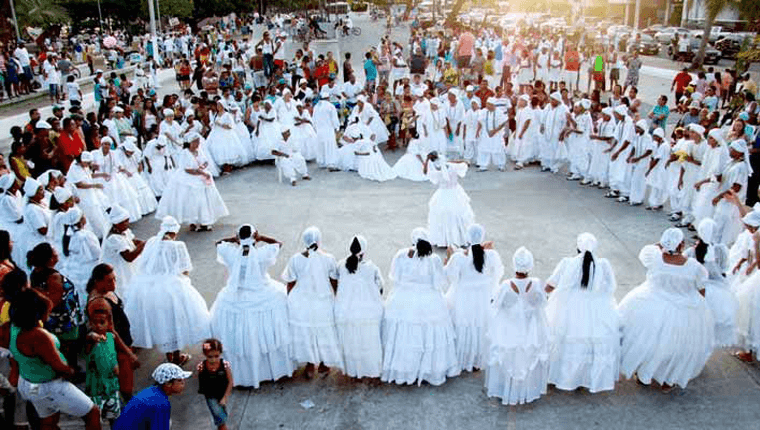
Candomblé is a vibrant Afro-Brazilian religion that blossomed in Brazil among enslaved Africans who sought to preserve their ancestral traditions.
Rooted in Yoruba, Fon, and Bantu beliefs from West and Central Africa, Candomblé was ingeniously adapted to the Brazilian context, blending with Indigenous and Catholic elements as a form of spiritual resistance and preservation.
Its creation in Brazil was a testament to the resilience of African cultures, maintaining a deep connection to the orixás (deities) through elaborate rituals, music, and dance.
Candomblé stands as a powerful symbol of cultural identity and spiritual endurance, celebrating the enduring legacy of Africa in Brazil’s religious and cultural landscape.
Santo Daime
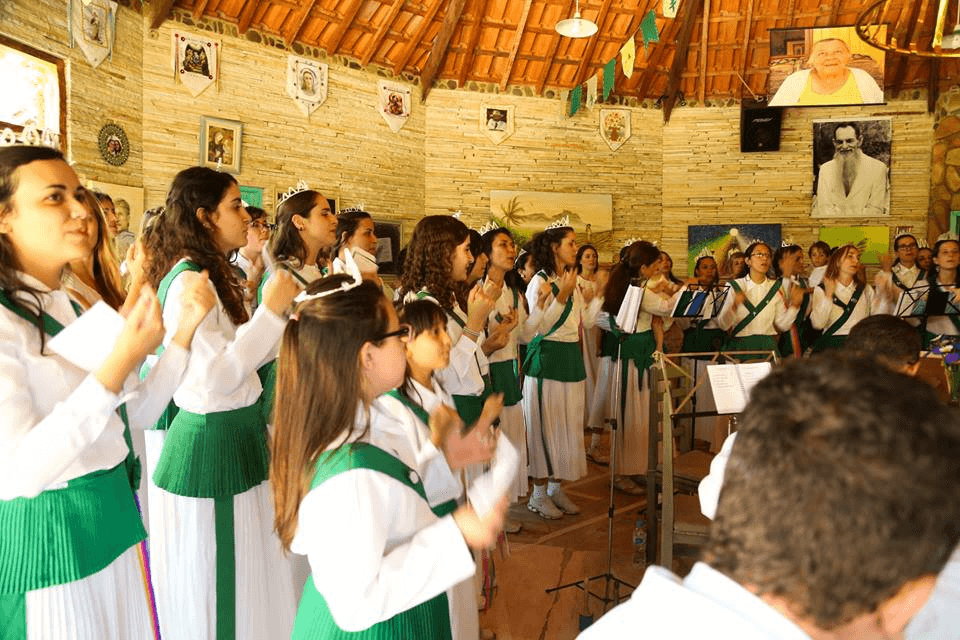
Santo Daime is a spiritual tradition that originated in the Brazilian Amazon in the 1930s. Founded by Raimundo Irineu Serra, who was influenced by his experiences with Indigenous peoples and their use of ayahuasca.
Santo Daime integrates Christian imagery and teachings with indigenous rituals involving the sacramental consumption of ayahuasca.
This brew, made from the Banisteriopsis caapi vine and Psychotria viridis leaves, is considered a means to spiritual enlightenment and healing.
Santo Daime represents a confluence of Indigenous, African, and European spiritual practices, embodying Brazil’s capacity for religious syncretism and innovation.
The religion is a testament to Brazil’s diverse spiritual landscape, offering a unique path to divine connection and community cohesion.
Shamanism
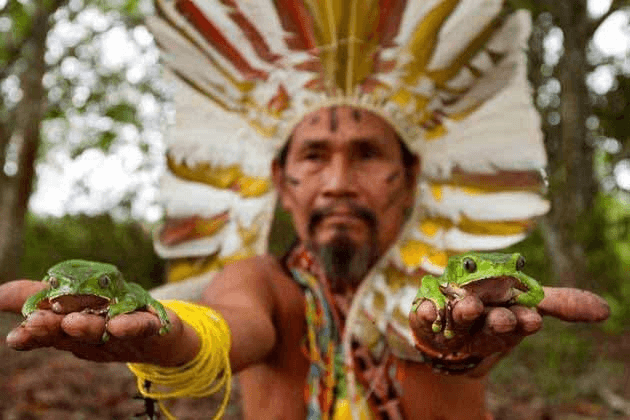
Shamanism in Brazil, particularly within Indigenous communities, encompasses a rich array of practices centered around connection with the natural world and spiritual realms.
These traditions, deeply rooted in the country’s Indigenous cultures, involve ceremonies that use sacred substances like ayahuasca and kambô (frog poison) for healing, vision quests, and communication with ancestral spirits.
Also See | Discover the 5 largest Amazon Rainforest Tribes and other information about all the peoples who live in the forest
Shamanic practices offer profound insights into the universe, emphasizing balance, healing, and respect for all living beings.
This spiritual approach reflects Brazil’s deep Indigenous heritage, showcasing a holistic understanding of health, community, and the environment.
Through shamanism, Brazil’s Indigenous peoples maintain a vital link to their ancestral wisdom, contributing to the country’s diverse spiritual landscape.
Brazilian Syncretism
10% of Brazilians say they believe in God, but don’t follow a specific religion and this can be clearly seen through the syncretism present in our culture, music, films and even in home decorations, which mix figures from different religions and beliefs on their altar.
I see myself as a syncretist, combining sympathy for Catholic figures, African religions and indigenous traditions.
This mixing goes beyond mere tolerance, embodying a deep respect and understanding that spiritual truths can be manifold and interconnected.
Such syncretism showcases Brazil’s ability to embrace diversity, creating a rich, shared spiritual landscape where different faiths enrich one another, fostering a sense of unity and shared humanity amidst diversity.
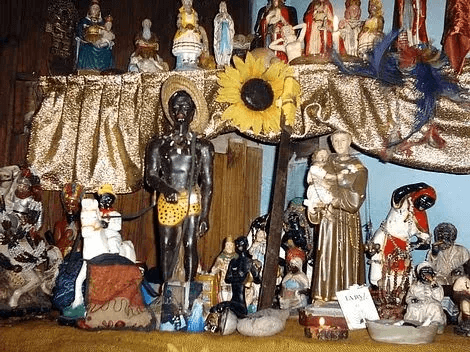
Principals Religions Temples in Brazil
Brazil’s religious temples are architectural marvels and spiritual beacons, reflecting the country’s rich tapestry of faiths.
Christ the Redeemer
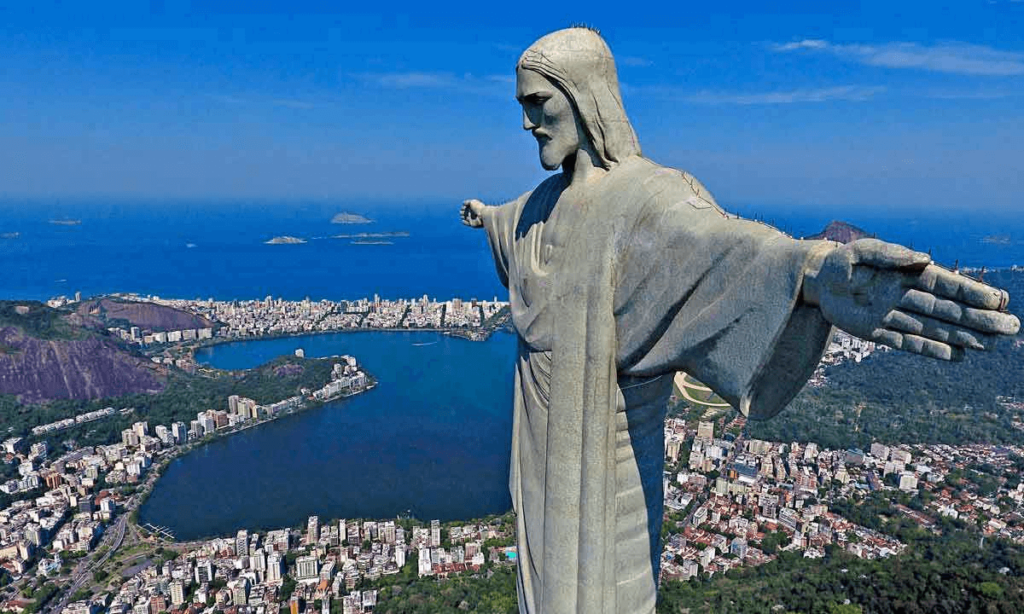
The Christ the Redeemer statue, an iconic symbol of Brazil, overlooks Rio de Janeiro from the summit of Mount Corcovado.
Beneath this monumental statue of Jesus Christ lies a lesser-known chapel, a place of worship where visitors can offer prayers and seek solace.
This combination of a global landmark and a sacred space perfectly encapsulates Brazil’s deep-rooted faith and its capacity to blend the monumental with the intimate in religious devotion.
Basilica of the National Shrine of Our Lady of Aparecida
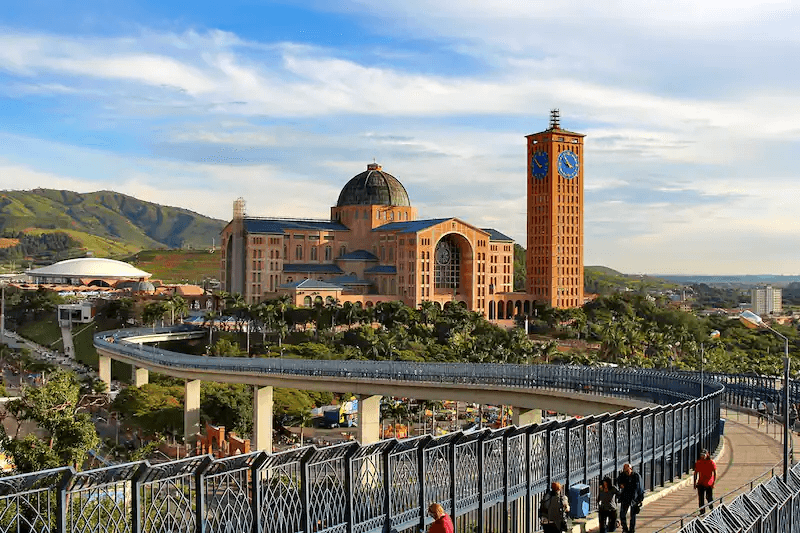
The Basilica of the National Shrine of Our Lady of Aparecida, nestled in the heart of São Paulo state, stands as a testament to the profound Marian devotion in Brazil.
It is the largest Marian shrine in the world, welcoming millions of pilgrims annually.
This majestic temple, dedicated to Our Lady of Aparecida, Brazil’s patron saint, embodies the nation’s deep Catholic faith and its reverence for the divine feminine.
Brasília Cathedral
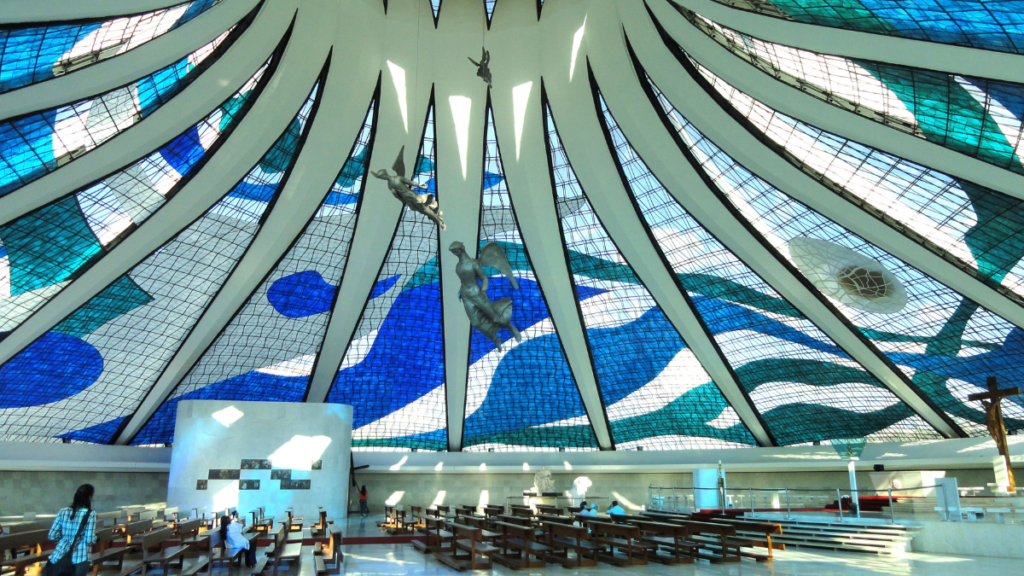
The Cathedral of Brasília, designed by the visionary architect Oscar Niemeyer, is a masterpiece of modernist architecture and a symbol of Brazil’s innovative spirit.
Its striking structure, featuring 16 concrete columns that form a crown-like shape, encapsulates a space filled with light, color, and spirituality.
This architectural marvel not only serves as a place of Catholic worship but also stands as a beacon of artistic and cultural expression in Brazil’s capital.
Embracing the Spiritual Mosaic: A Reflection on Brazil’s Religious Harmony
In the heart of Brazil lies a kaleidoscope of faiths, each with its unique traditions, celebrations, and sacred spaces.
From the awe-inspiring Christ the Redeemer to the serene Brasília Cathedral, the country’s religious landscape is a testament to its rich cultural heritage and the unifying power of belief.
Brazilian spirituality, marked by diversity, syncretism, and profound devotion, mirrors the vibrant, inclusive, and resilient spirit of its people.
As we explore these sacred grounds and the beliefs they embody, we’re invited to appreciate the depth and breadth of Brazil’s soul—a journey that transcends borders, inviting all to find common ground in the universal quest for meaning and connection.
Did you like our content, do you want to get to know our country?! Discover the best experiences to live in Brazil!
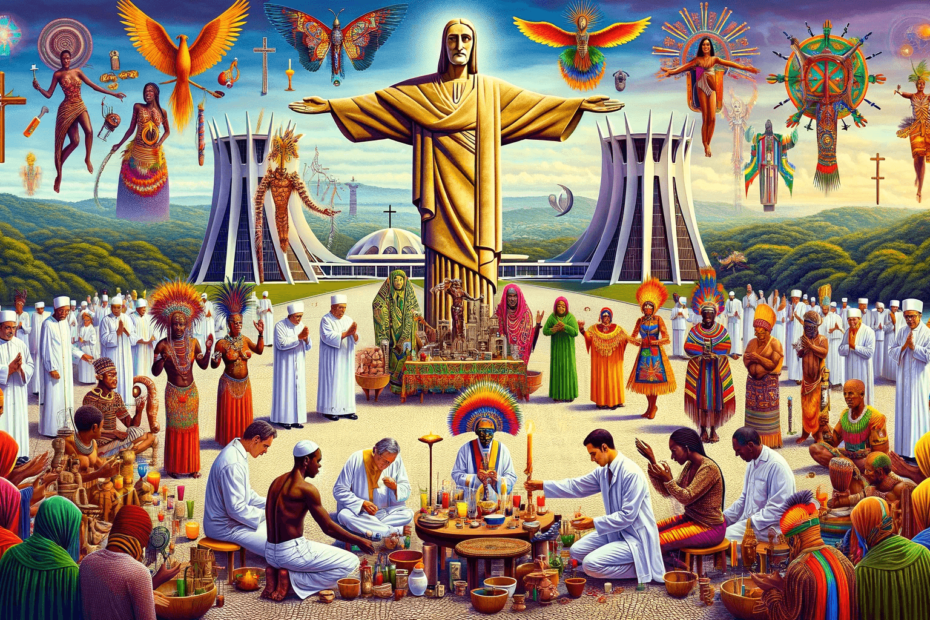
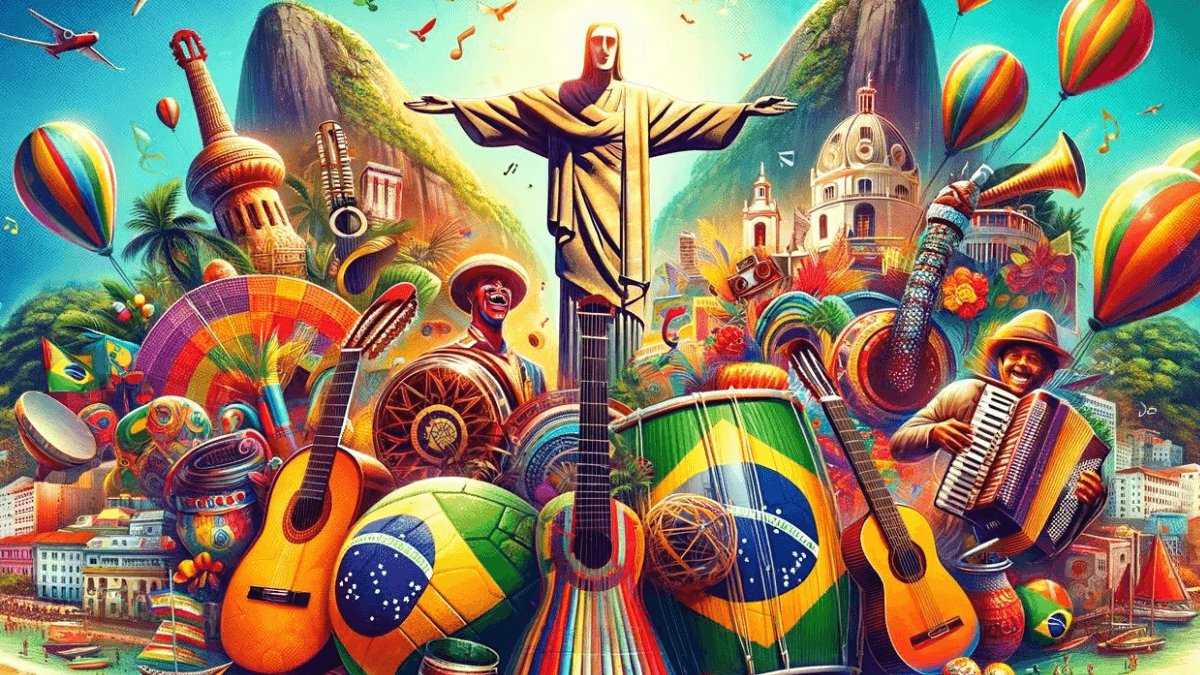
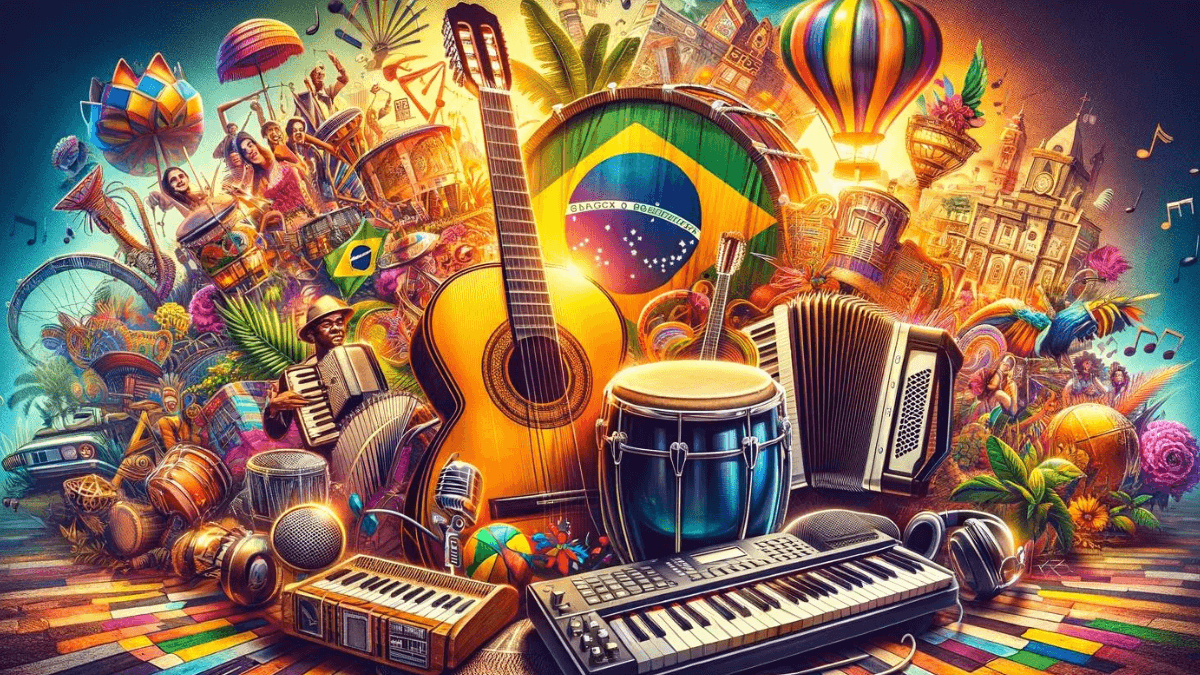
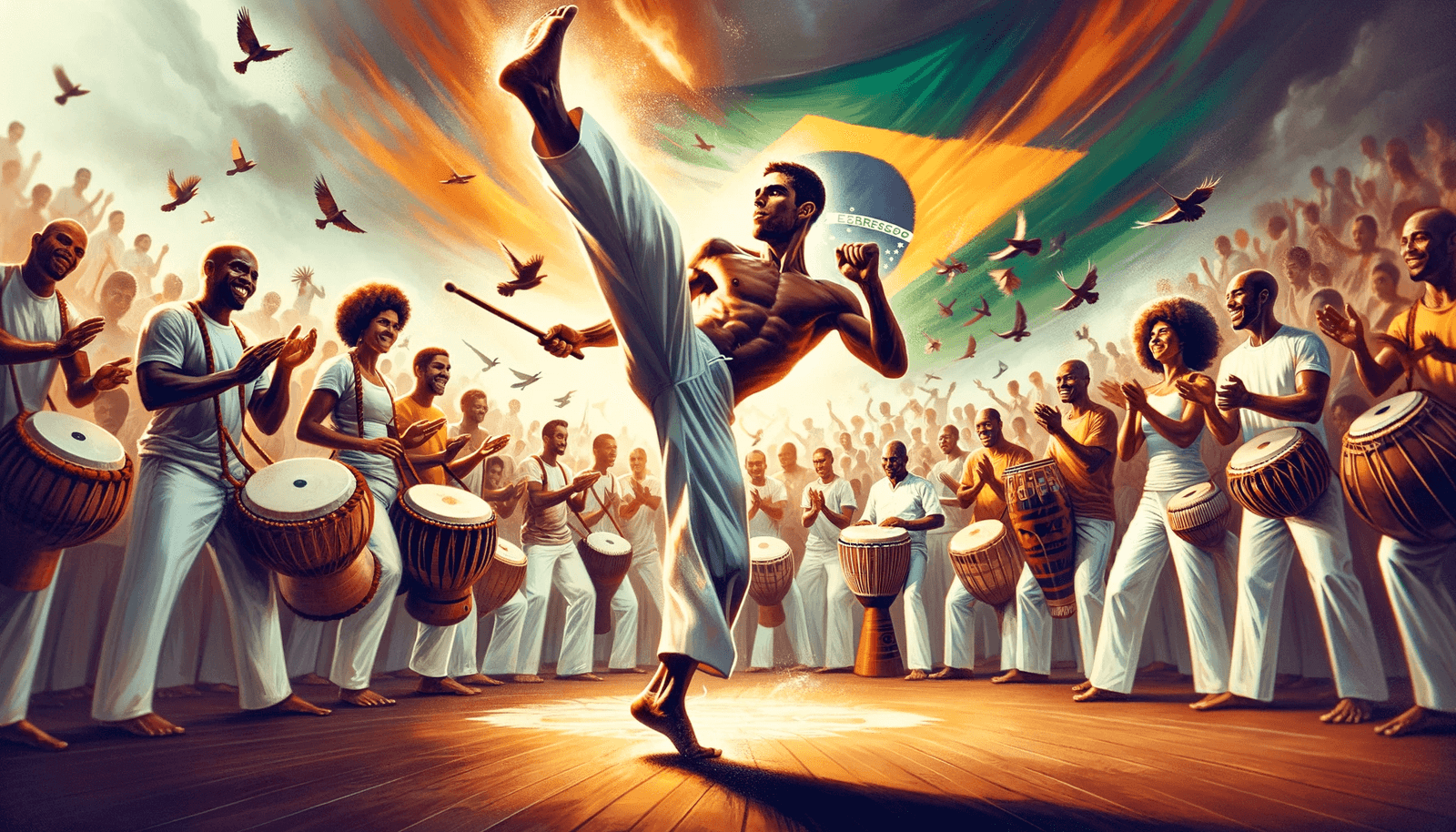

Awesome!